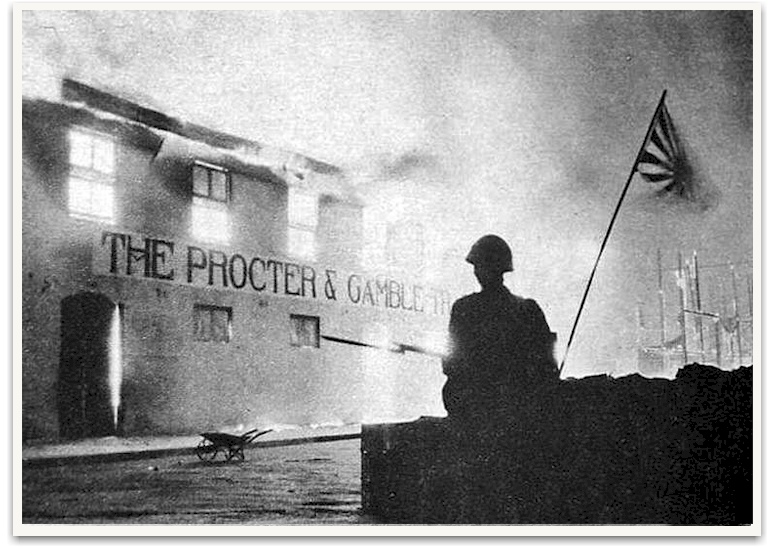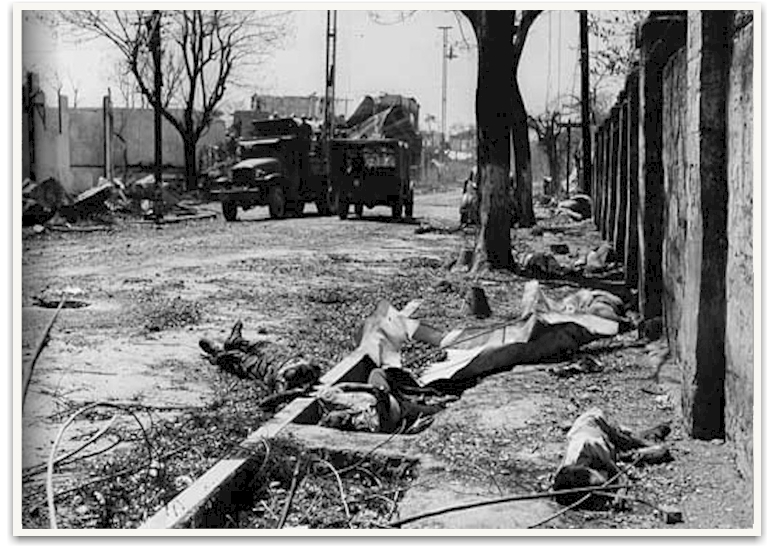|
Around the middle of December, 1944, Japanese marines began to erect
obstructions in many of the streets of Ermita. Concrete barriers, strewn
with interlacing barbed wires, were placed along these streets, some of
which were also sowed with
deadly land mines and aerial bombs buried with their fuses protruding
slightly above the surface of the street. Pill boxes were built in a hurry
in certain strategic places. Our house was a corner house and its fence
had an ornate iron railing embedded atop a concrete base that was about a
meter or so in height. The
Japanese entered our house and constructed an elaborate pill box at the
corner where two rectangular openings were chiseled out the fence’s
concrete base and through which were positioned two clip fed high caliber
guns. The guns commanded a wide expanse of the eastern length of Isaac
Peral and the southern approach to Florida Streets. The soldiers also dug
a trench from the pill box leading directly to the crawl space under our
house. Many pre-war Manila houses, especially those built of concrete, had
its first floor constructed about a meter or so above the ground, thus
creating crawl space between the ground and the first floor. Diagonally
across the pill box was the campus of the University of the Philippines
(UP) and on its eastern side, the Episcopalian Cathedral, both of which
had been commandeered and occupied by the Japanese. Sentries were posted
on the eastern corners of Isaac Peral Street but the Japanese soldiers
manning these posts did not carry guns but were only armed, amazingly,
with a spear made from a long
wooden pole to which was attached a sharp blade.
I remember that February 3, 1945, was a Saturday because my father told me
not to hear Mass the next day at the Ermita Church as it now seemed too
dangerous to be walking about the streets. Early in the evening of the
same day, my father received a telephone call from a relative who lived in
the Santa Cruz district of Manila. The message was short but direct to the
point: “The Americans were now in the northern part of Manila!” Shortly
after this call, all telephone communication was cut off. About
mid-afternoon of Sunday, February 4, we heard several extremely loud
explosions north of where we were. My father thought aloud and said that
the Japanese must be blowing up the bridges that spanned the Pasig River.
He was right. Electricity and water supply had been cut off even earlier.
My mother had the foresight of collecting potable water in several
demijohns. She also had an artesian well dug in our yard but the water
that was pumped out was salty as we were very near Manila Bay.
On February 5 or 6, a Piper Cub, a single engine American observatory
plane, flew over Ermita and Malate and dropped leaflets. One, I recall,
announced that General MacArthur had landed in Leyte earlier in October of
1944. We got a good look at this Piper Cub as it flew over us at a rather
low altitude. What struck most of us as odd was the insignia on the plane.
We remembered that the insignia on American airplanes was a big white star
with a red ball in the middle. The insignia on the Piper Cub was a white
star with two wide white strips on each side.
No sooner had the Piper Cub left than the American shelling began. To be
in the receiving end of an incoming shell is about the most frightful
experience one can ever live through.
An incoming shell sounds very much like a speeding freight train
coming straight at you. Because of the Doppler effect, the pitch of its
screech gets higher and higher as it nears you, if you are, or if you are
near, its intended target. A shell hit the Prince Hotel, which was just at
the back of our house, severely wounding Mr. Wing, its Chinese proprietor.
We were shelled daily. The shelling at night was even more frightful as we
were in total darkness. The house of Dr. Rafael Moreta, our immediate
neighbor, was hit by a shell in the evening of February 8. My mother
invited the Moreta family to come to our house as our house was more
strongly built and the Moretas were all cramped in an air raid shelter in
their yard.
The darkness of night on February 9 was suddenly lifted by the glow of
raging fires that broke out all over Ermita. It seemed that the Japanese
were setting fire to the houses in our neighborhood. Except for the
Episcopalian Church and the buildings in the UP campus (both of which were
occupied by the Japanese), fires raged all around us. My cousin Anselmo
Salang was attempting to tear down the sawali matting [woven strips of
split bamboo used for partitions] that hung on the fence separating our
house from the Prince Hotel, when a Japanese soldier, standing on the
steps of the Episcopalian Cathedral drew a bead on him and shot him,
narrowly missing his head by just a foot. Civilians, whose homes were on
fire, came streaming to our house to seek shelter. By around midnight of
February 9, there were about 120 people huddled in the ground floor of our
home.

They set the fires, and shot anyone seen
fleeing the burning buildings.
In the morning of February 10, a Japanese officer came to our house and
told us that we all had to leave in an hour’s time. We quickly packed
small packages of whatever food we could gather, but in less than half an
hour, a squad of fully armed Japanese marines came to our house and
mounted a machine gun pointed at our front entrance. We were told to leave
immediately. The elders in
our house had earlier decided to seek refuge at the Ateneo University or
at the Philippine General Hospital (PGH) at Padre Faura Street. As we
streamed out of the main entrance of our home, the Japanese soldiers began
rummaging through our belongings, opening bags, and helping themselves to
whatever they found. I clearly remember one Japanese marine taking a wad
of Japanese wartime peso notes from the handbag of an elderly lady as if
there were still any place where he could have spent such useless paper
bills! I now realize that the Japanese did not kill all of us, all 120 or
so of us, because it would have been too much trouble getting rid or
burying so many dead bodies. They were anxious to get into our house to
feast on whatever they would find inside.
The only way from our house in Isaac Peral to the PGH or the Ateneo was
through Florida Street. Those who came out of our house first, walked
ahead of the rest that came later. I remember walking on Florida Street
towards Padre Faura Street with my elder brother George, Jr. to my left.
My mother was slightly ahead of me and to my right. To my left also and
about four meters ahead of me, carrying a basket on her head, was fifteen
year old Leonarda “Narda” Pangan, a native of Dinalupihan, Bataan, my
mother’s hometown. Florida Street was strewn with debris. The buildings
along its side across the UP campus were all razed by the fires that raged
the night before. Florida Hall, the boarding house for the female students
of the UP, was just a pile of smoking rubble as were the other buildings
along the whole length of Florida Street. We were nearing Arkansas Street
(now Engracia C. Reyes), which ran directly perpendicular to the entrance
of the UP College of Engineering, now the Court of Appeals, when my mind
began to wander a bit as I recalled that it was at this very same spot
where, a year or so ago, the Japanese sentry posted at the gate leading to
the building of the College of Engineering shouted at me with a shrill
Kura Kura! as I passed him on the other side of the street. I knew
immediately that I had failed to stop and to bow before I passed him. I
quickly retraced my steps, stood in front of the sentry, and bowed bending
from my waist. I may have gotten off easy as the sentry did not command me
to come forward to be slapped but just waved me on after I had bowed.
My bit of day-dreaming was suddenly interrupted by a horrendous and
ear-splitting explosion ahead of me and to my left. I glanced to my left
and saw my elder brother George Jr. standing with both hands covering his
face. About two meters in front of him, lay the legless torso of a woman
with long black hair, whose left arm was also amputated up to the
shoulder. She lay moaning,
blood flowing from the stump of her lower torso. My mind was in a daze and
my ears were ringing but I soon realized that this hapless woman was the
fifteen year old Narda. She had stepped on an anti-personnel land mine! As
I gazed to my right, I saw my mother lying on the ground on her right
side, all bloodied and motionless. I rushed to her side as I called to her
but I received no response. Suddenly, someone shouted “Run, save
yourselves!” Many in our
group just dropped whatever they were carrying and ran towards Padre Faura
Street. Anselmo Salang, my cousin, heroically took it upon himself to
carry my mother, as we all madly rushed towards Padre Faura Street and
into the PGH. Slowly, we found each member of our family in the interior
court yard of the PGH. Doctors attended to my mother as best as they could
and she was placed on a bed in a ward on the second floor of the hospital
facing Taft Avenue. My brother George, Jr., blinded by the land mine
blast, was placed on a bed at another ward. The rest of us, including
Robert Reyes, my seven month old first cousin being cared for by my
maternal grandmother, sought shelter at the Nurses’ Home, a two-story
building on the corner of Taft Avenue and Padre Faura Street, which served
as dormitory for the nurses on duty. The mangled body of poor Narda was
left where it lay on Florida Street.

Go to Page 3
|

